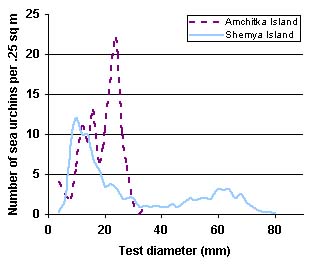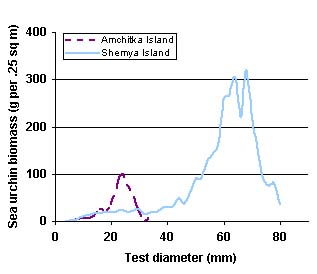A study compared the community structure of two western Aleutian Islands with and without sea otters in the early 70s. The islands physically similar and are in close proximity.
- AMCHITKA ISLAND. Population surveys reported an estimated 20 to 30 sea otters per square kilometer of habitat. This has existed for about 20 to 30 years.
- SHEMYA ISLAND. There have been scattered sightings of sea otters around this island, but no population had reestablished at the time of the study.
|
Figure 1 compares the number of sea urchins present per quarter square meter with the size of the sea urchins.
- AMCHITKA ISLAND. Large sea urchins are absent.
- SHEMYA ISLAND. There is a high number of small sea urchins present. Additionally, larger sized sea urchins are also found.
(Figure modified from data presented in Estes and Palmisano, 1974)
Figure 2 compares the sea urchin biomass with the size of the sea urchins. Biomass refers to the total weight of the sea urchins per quarter square meter samples.
- AMCHITKA ISLAND. Low biomass of sea urchins.
- SHEMYA ISLAND. High sea urchin biomass. This makes sense since there are considerably more larger sized sea urchins.
|
|
||||||||||||||||||
Table 1 compares the amount of kelp and invertebrates in the waters around Amchitka and Shemya Islands. Notice that Amchitka Island has significantly less sessile mobile invertebrates, and much more kelp present. The lack of mobile herbivorous invertebrates allow kelp density to increase.
- Presence of sea otters is the major difference between these two islands.
- How do you think sea otters affect the community structure?
This web site was created by Lynn Tran at the North Carolina State University, Department of Mathematics, Science, and Technology Education on 7/12/03. Faculty advisor Dr. David Eggleston, NCSU, Department of Marine, Earth, & Atmospheric Sciences. Last updated December 29, 2003 .

